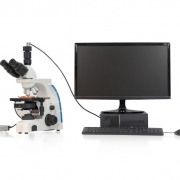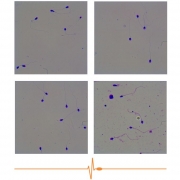Multispecies sperm analysis ISAS V1 for Sperm tests, which are increasingly widespread evidence among the animal and human population. Hence, there is an increasing supply of systems on the market and, by extension, it is increasingly necessary to have systems that offer greater efficiency in the results obtained.
In Proiser we are aware of this, that is why we have developed the ISAS V1 method, a system that gathers tools to be used both in clinics and in research.
Its fields of application are both the field of human sciences and those related to veterinary, scientific research, livestock production or pharmaceutical and reproductive toxicology.
ISAS V1 is currently considered to be the most complete and easy-to-use sperm analysis system of all we can find on the market. This is mainly because it works under different hardware conditions and with different operating systems, so it adapts to the needs of all types of users.

Caption from DNA Fragmentation-. ISAS V1
Multispecies sperm analysis ISAS V1: What it is and what applications it has
ISAS V1 is a sperm analysis system suitable for multiple species, so it can work with different sperm samples. It doesn’t matter if it is to analyze the sperm sample of a man, a horse, a bull, a pig, a goat, rabbit, dog, rat, lamb, etc. It’s valid for all of them. This does not imply that ISAS V1 always applies the same parameters. On the contrary, each species has its own configuration algorithms and results in independent analysis.
Depending on the sample, ISAS may use negative or positive phase contrast. The motility analysis of a field is performed in real time (less than one second), and can be configured to analyze motility up to 250 frames, at 200 frames per second and with concentrations greater than 1000 sperm/field.
In addition to the concentration, motility and percentage of progressives, with ISAS V1 the following kinetic parameters are also calculated: VCL, VSL, VAP, LIN, STR, WOD, ALH, BCF, DNC, MAD, among others.
It should also be noted that it works with cameras up to 200 frames per second, allowing for near-perfect analysis of sperm behavior.
In addition, it is specially designed for quality control programs, allowing the analysis of video files of many different formats (Windows AVI, Windows Media Video, MPEG-4, DV among others). It also allows to obtain images, which makes it easier to have collections of videos and images for offline analysis of mobility, concentration, morphology, vitality or DNA fragmentation.
Another application of ISAS V1 is the morphological and morphometric analysis of sperm from dyed or fresh samples (using phase contrast optics).
This work provides data on 14 morphometric parameters: head size (area, length, width and perimeter), head shape (ellipticality, elongation, roughness, and regularity), percentage of acrosome, head color level, centerpiece size (area and width), and insertion of the middle part (angle and distance).
With ISAS we can also know the data related to the percentage of fragmented sperm. To do this, it uses 20x or 40x real-time (less than 1 second) targets.
Finally, it should be noted that ISAS V1 also provides data on automatic feasibility of sperm cells. This is especially interesting because we need to determine the actual percentage of viable cells in a sample, and to accurately perform this analysis, we use fluorescence techniques with their corresponding use of tying kits.

Caption From Vitality test-. ISAS V1
FEATURES of the ISAS V1 system
The current ISAS V1 equipment is completely modular, so each part of it can operate independently and together.
In addition, we have designed the system to allow most of the components that can be found in each type of laboratory, from the microscope to the computer, as long as they meet the minimum system requirements.
So, if you are looking for a system with which you can do high quality multispecies sperm analysis and be able to obtain a large number of data, do not hesitate and come to Proiser. You’ll find everything you need.






















